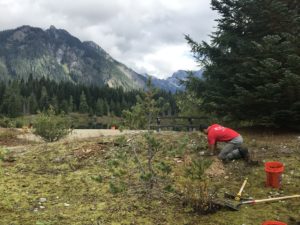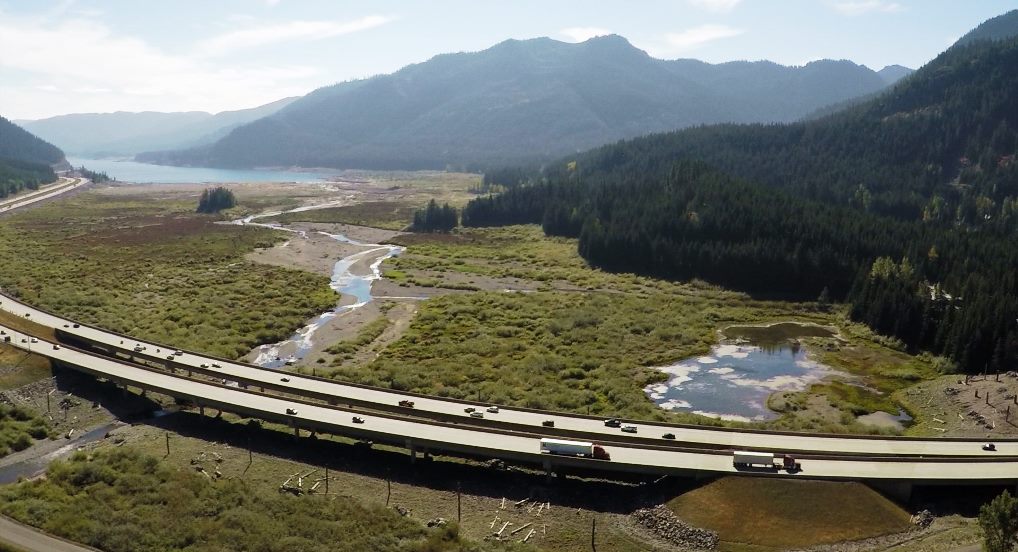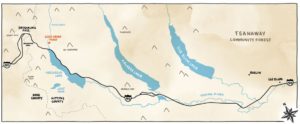In Washington state, the not-for-profit group, Conservation Northwest, is joining a coalition to restore Gold Creek and increase wildlife biodiversity, ecosystem health and resilience to climate change in an important watershed near Snoqualmie Pass.
Through their Central Cascades Watersheds Restoration (CCWR) program, they are increasing our focus on habitat restoration, watershed health and landscape-scale connections between the Alpine Lakes Wilderness and Mount Rainier National Park.
And, as their I-90 Corridor Campaign sunsets successfully, they’re still paying close attention to progress on wildlife crossings and needs for habitat restoration in the Snoqualmie Corridor.
There’s been an ongoing issue centered around Gold Creek, adjacent to I-90 near Hyak—an area that they are quite familiar with from years of wildlife monitoring and research to inform crossing structures, as well as from engaging volunteers in habitat restoration work parties.
Conservation Northwest has now joined a broad coalition of indigenous leaders, conservation groups, public land and resource managers, and neighbors to address this issue, and restore Gold Creek.
A creek in need of restoration
Gold Creek was once a healthy wetland habitat, teeming with biodiversity. Today, it’s an ecosystem dangerously out of balance. For decades, Gold Creek and the surrounding habitat have been degraded from freeway construction, dams, gravel pits, and other development.
One of the main culprits is also one of its best-known features: Gold Creek Pond. This scenic pond was once a massive gravel pit that supplied construction of I-90. It was never restored to its natural wetland state, as was originally planned, and now, it can’t support native species that should thrive there.
For years, Conservation Northwest has partnered with Okanogan-Wenatchee National Forest staff and volunteers to remove invasive plants and replant native vegetation near the pond. But with the scale of restoration actually needed here, these efforts have been more of a short-term band aid.
The construction of the pond has altered the hydrology of the system, that is, the way water moves across the entire valley floor. At 60 feet deep, the pond functions as a siphon, pulling water away from Gold Creek, exacerbating the annual dry period in late summer. The increasing severity of these dry periods prevents species like endangered bull trout from swimming upstream to spawn.
Without fundamentally repairing the hydrology and restoring the essential wetland functions needed to support this diverse ecosystem, the efforts we’ve made to improve this habitat will fall short.
The Gold Creek Restoration Project

A volunteer plants native vegetation near Gold Creek in the Snoqualmie Pass wildlife corridor. Photo: Laurel Baum.
In 2020, there’s a chance to set things right. A coalition including the Kittitas Conservation Trust (KCT), Yakama Nation Fisheries, the U.S. Forest Service, the Washington Department of Fish and Wildlife, the Yakama Nation, Conservation Northwest, Forterra and others are coming together to restore Gold Creek and improve habitat conditions so that keystone species like bull trout can thrive, thereby restoring the entire ecosystem to a more natural state.
While some of the restoration project’s activities may disrupt use and access in the short-term, it will result in long-term ecological health and resiliency, benefiting future generations.
The valley can be home to a balanced ecosystem with healthier soil, abundant native plants, a greater diversity of wildlife, and increased resiliency in the face of a changing climate. ADA-accessible and family-friendly recreation trails are a priority in the project, and will be maintained so visitors can continue to enjoy this landscape.
The plans at Gold Creek are part of a larger effort to restore the headwaters of the Yakima River and improve wildlife habitat across the Snoqualmie Pass region. This vitally important landscape has already been improved by establishing several wildlife crossings through our I-90 Wildlife Crossing Campaign.
Conservation Northwest has also participated habitat restoration efforts ongoing in Box Canyon, the Cle Elum River, and Upper Kachess River. They are committed to seeing this next phase of restoration move forward to build on the progress already made for wildlife connectivity in this landscape.
The U.S. Forest Service will begin an environmental review process in early 2020 to evaluate possible strategies and determine which restoration plan makes the most sense.
Featured photo (courtesy of Matt Johnson) shows the new Gold Creek Wildlife Undercrossing.


